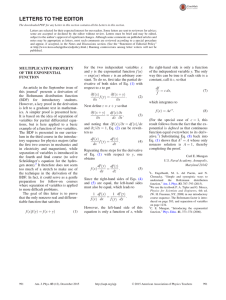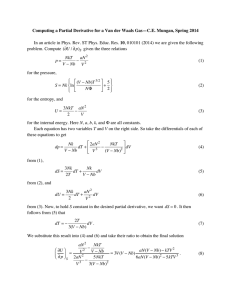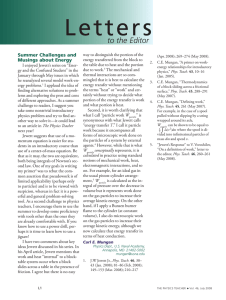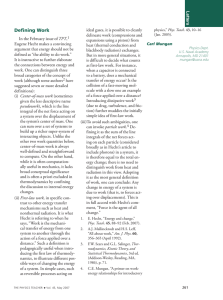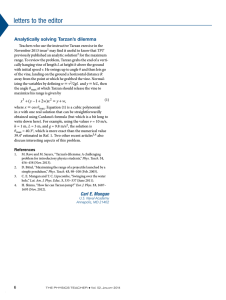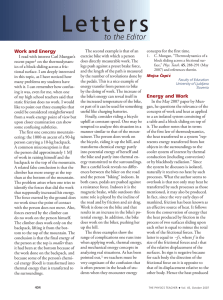In defense of derivations,
advertisement
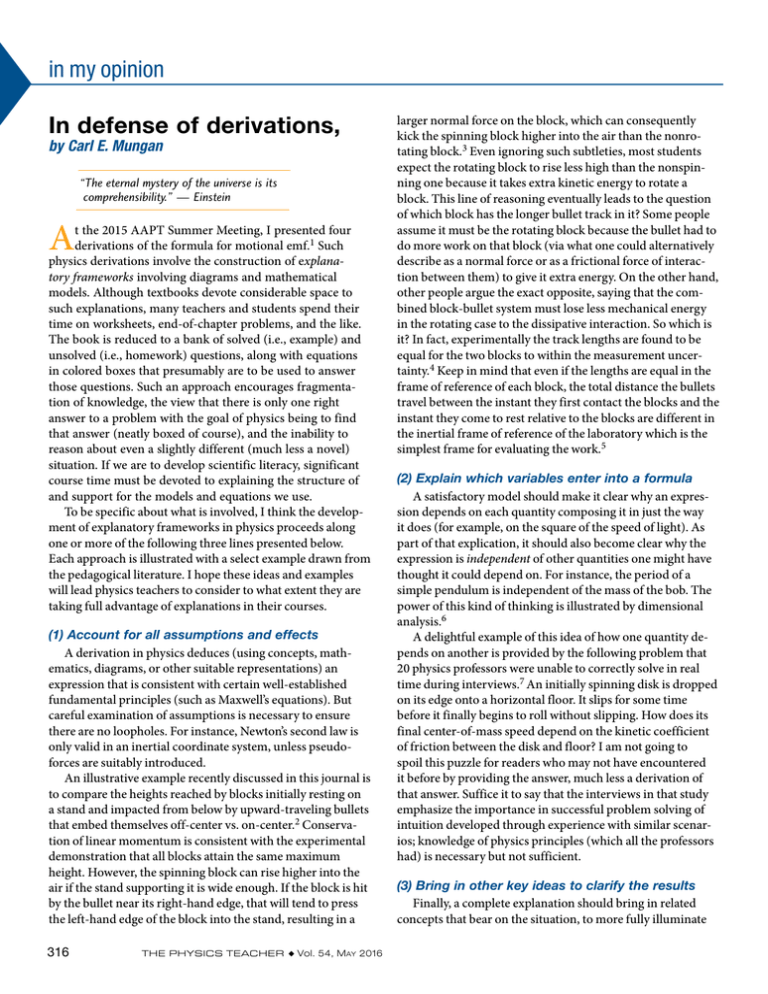
in my opinion In defense of derivations, by Carl E. Mungan “The eternal mystery of the universe is its comprehensibility.” — Einstein A t the 2015 AAPT Summer Meeting, I presented four derivations of the formula for motional emf.1 Such physics derivations involve the construction of explanatory frameworks involving diagrams and mathematical models. Although textbooks devote considerable space to such explanations, many teachers and students spend their time on worksheets, end-of-chapter problems, and the like. The book is reduced to a bank of solved (i.e., example) and unsolved (i.e., homework) questions, along with equations in colored boxes that presumably are to be used to answer those questions. Such an approach encourages fragmentation of knowledge, the view that there is only one right answer to a problem with the goal of physics being to find that answer (neatly boxed of course), and the inability to reason about even a slightly different (much less a novel) situation. If we are to develop scientific literacy, significant course time must be devoted to explaining the structure of and support for the models and equations we use. To be specific about what is involved, I think the development of explanatory frameworks in physics proceeds along one or more of the following three lines presented below. Each approach is illustrated with a select example drawn from the pedagogical literature. I hope these ideas and examples will lead physics teachers to consider to what extent they are taking full advantage of explanations in their courses. (1) Account for all assumptions and effects A derivation in physics deduces (using concepts, mathematics, diagrams, or other suitable representations) an expression that is consistent with certain well-established fundamental principles (such as Maxwell’s equations). But careful examination of assumptions is necessary to ensure there are no loopholes. For instance, Newton’s second law is only valid in an inertial coordinate system, unless pseudoforces are suitably introduced. An illustrative example recently discussed in this journal is to compare the heights reached by blocks initially resting on a stand and impacted from below by upward-traveling bullets that embed themselves off-center vs. on-center.2 Conservation of linear momentum is consistent with the experimental demonstration that all blocks attain the same maximum height. However, the spinning block can rise higher into the air if the stand supporting it is wide enough. If the block is hit by the bullet near its right-hand edge, that will tend to press the left-hand edge of the block into the stand, resulting in a 316 THE PHYSICS TEACHER ◆ Vol. 54, May 2016 larger normal force on the block, which can consequently kick the spinning block higher into the air than the nonrotating block.3 Even ignoring such subtleties, most students expect the rotating block to rise less high than the nonspinning one because it takes extra kinetic energy to rotate a block. This line of reasoning eventually leads to the question of which block has the longer bullet track in it? Some people assume it must be the rotating block because the bullet had to do more work on that block (via what one could alternatively describe as a normal force or as a frictional force of interaction between them) to give it extra energy. On the other hand, other people argue the exact opposite, saying that the combined block-bullet system must lose less mechanical energy in the rotating case to the dissipative interaction. So which is it? In fact, experimentally the track lengths are found to be equal for the two blocks to within the measurement uncertainty.4 Keep in mind that even if the lengths are equal in the frame of reference of each block, the total distance the bullets travel between the instant they first contact the blocks and the instant they come to rest relative to the blocks are different in the inertial frame of reference of the laboratory which is the simplest frame for evaluating the work.5 (2) Explain which variables enter into a formula A satisfactory model should make it clear why an expression depends on each quantity composing it in just the way it does (for example, on the square of the speed of light). As part of that explication, it should also become clear why the expression is independent of other quantities one might have thought it could depend on. For instance, the period of a simple pendulum is independent of the mass of the bob. The power of this kind of thinking is illustrated by dimensional analysis.6 A delightful example of this idea of how one quantity depends on another is provided by the following problem that 20 physics professors were unable to correctly solve in real time during interviews.7 An initially spinning disk is dropped on its edge onto a horizontal floor. It slips for some time before it finally begins to roll without slipping. How does its final center-of-mass speed depend on the kinetic coefficient of friction between the disk and floor? I am not going to spoil this puzzle for readers who may not have encountered it before by providing the answer, much less a derivation of that answer. Suffice it to say that the interviews in that study emphasize the importance in successful problem solving of intuition developed through experience with similar scenarios; knowledge of physics principles (which all the professors had) is necessary but not sufficient. (3) Bring in other key ideas to clarify the results Finally, a complete explanation should bring in related concepts that bear on the situation, to more fully illuminate opinion what is going on. For example, the range formula for projectile motion is first deduced in the introductory course from the basic kinematic equations for constant acceleration. Later, conservation of linear momentum is seen to be consistent with the constancy of the horizontal component of the projectile’s velocity. Likewise, conservation of mechanical energy throws light on the particle’s gain in vertical velocity as it falls. A much richer student understanding of motion in a uniform gravitational field results. I suggest that a complete explanation should provide an “aha” moment and not just a logical deduction. For example, why are planetary orbits elliptical in shape? The traditional derivation is that conic sections are the solution of Newton’s second law for the universal law of gravity. A common step in this process is to make the change of variables to u = 1/r, where r is the radial distance from the sun to the planet, and the mathematics proceeds in a similar sequence of valid but cryptic manipulations.8 As a student, that left me unsatisfied. How can a central force lead to a noncircular orbit? Bringing in the conservation laws provides insights into that issue. A circular orbit is described by a single constant, namely the radius. However, there are two independent constants of orbital motion, to wit the mechanical energy E and the angular momentum L. Thus the circle needs to be distorted in such a manner that it has two effective radii, described by the semimajor and semi-minor axes. One can directly deduce Kepler’s first law 9 from expressions for these two constants E and L. A fixed negative value of E with positive values of L varying from zero up to some maximum leads to orbits ranging in eccentricity from 1 down to 0, respectively.10 References 1. http://www.aapt.org/docdirectory/meetingpresentations/SM15/ Mungan2015.pdf . 2. A. Shakur, “Bullet-block science video puzzle,” Phys. Teach. 53, 15–16 (Jan. 2015). 3. A. J. Mallinckrodt, “Blocks and bullets demo,” Phys. Teach. 36, 198–199 (April 1998); E.R. Cowley, G.K. Horton, and B.E. Holton, “Another surprise in mechanics,” Phys. Teach. 37, 188–191 (March 1999). 4. E. R. Cowley, B. Holton, and G. K. Horton, “A thought-provoking demonstration,” Phys. Teach. 36, 24–26 (Jan. 1998). 5. C. E. Mungan, “Impulse and work for the bullet-block Veritasium video,” Phys. Teach. 53, 325–326 (Sept. 2015). 6. C. F. Bohren, “Dimensional analysis, falling bodies, and the fine art of not solving differential equations,” Am. J. Phys. 72, 534–537 (April 2004). 7. C. Singh, “When physical intuition fails,” Am. J. Phys. 70, 1103– 1109 (Nov. 2002). 8. G. R. Fowles and G. L. Cassiday, Analytical Mechanics, 6th ed. (Brooks/Cole, Belmont CA, 1999), Sec. 6.5. 9. E. Vogt, “Elementary derivation of Kepler’s laws,” Am. J. Phys. 64, 392–396 (April 1996). 10. http://www.csaapt.org/uploads/3/1/2/7/3127390/csaapt_ mungan_spring2015.pdf . Carl E. Mungan is a professor at the U.S. Naval Academy, Annapolis, MD, celebrating his 20th year on the tenure track teaching undergraduate physics. mungan@usna.edu THE PHYSICS TEACHER ◆ Vol. 54, May 2016 317
